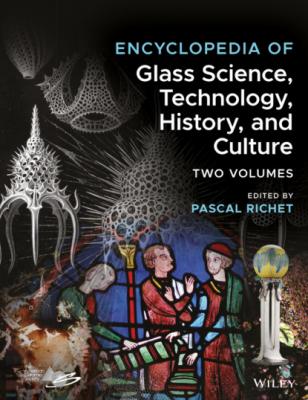Encyclopedia of Glass Science, Technology, History, and Culture. Группа авторов
Читать онлайн.| Название | Encyclopedia of Glass Science, Technology, History, and Culture |
|---|---|
| Автор произведения | Группа авторов |
| Жанр | Техническая литература |
| Серия | |
| Издательство | Техническая литература |
| Год выпуска | 0 |
| isbn | 9781118799499 |
(2)
where A, B, and T0 are empirical fit constants and T is expressed here in °C. The float glass DGG‐1 included in Figure 3 is a certified viscosity standard whose VFT equation has been derived from 44 measurement points. These are reproduced with the parameters A = −1.601, B = 4330.9, and T0 = 246.1 (η in dPa·s) with a standard deviation of δlog η = ± 0.16, illustrating that the VFT equation is a valuable tool for any technological purpose.
Viscosities are in addition an indicator of crystallization tendency at the liquidus temperature Tliq, which is shown in Figure 3 on the viscosity curves. Melts with log η(Tliq) < 2.0 tend to crystallize quickly, thus requiring very high cooling rates, whereas melts with η(Tliq) > 4.0 may in contrast be vitrified at moderately low cooling rates.
Of great interest, therefore, is the possibility to predict the viscosity of a glass melt as a function of its temperature and chemical composition. From measurements performed for a variety of samples, sets of incremental factors have been empirically derived by regression analysis for this purpose. The left‐hand part of Table 3 presents such a widely used database [19] with which the effect of additions of individual oxides (by weight and molar amounts, respectively) have been calculated for a soda‐lime silicate. The temperature T(n.n) at which viscosity reaches 10n.n dPa·s is thus calculated as
(3)
where y(j) is the weight fraction of oxide j.
Helpful guidelines for the design of the viscosity curve of a mass‐produced glass may be derived from the graphs of Figure 4. For example, replacement of 1 wt % SiO2 by 1 wt % Li2O to yield a glass 73 wt % SiO2, 10 CaO, 16 Na2O, 1 Li2O lowers the temperature at log η = 4.0 and 13.0, relative to the base glass, by 45 and 29 K, respectively. Among the alkali oxides, lithia is the strongest liquidus flux; it significantly lowers viscosity at all levels. Boron oxide has a similarly strong effect, however, at high‐temperature only. So it reduces the working range (the “length”) of a glass. In the language of glass technologists, boron oxide makes a glass “short.” Lime strongly reduces viscosity at high temperatures; the effect is almost as strong as with soda. Thus, if viscosity needs to be lowered in this range, inexpensive limestone as a calcium carrier raw material may be used instead of expensive soda ash as a sodium carrier. Also note that lime, quite in contrast to magnesia, makes a glass “short.” One can thus extend the working range of a glass by manipulating its CaO/MgO ratio. Alumina makes at the same time a glass more viscous and “longer.” Although not giving any in‐depth scientific understanding, these empirical tools undoubtedly have their merits in glass technology.
Table 3 Empirical factors for the calculation of viscosities [19] and elastic properties [21, 22] (units revisited) from composition.
| Oxide j | Viscosity | Elastic properties | ||||
|---|---|---|---|---|---|---|
| a(j) for | Validity range (wt %) | V(j) (cm3/mol) | U(j) (GPa) | |||
| T(2.0) (°C) | T(4.0) (°C) | T(6.0) (°C) | ||||
| SiO2 | 1847.80 | 1249.70 | 962.90 | 60–77a | 28.0 | 64.5 |
| TiO2 | −4.00 | −4.00 | −4.00 | 0–8b | 29.2 | 86.7 |
| ZrO2 | 8.65 | 7.96 | 8.16 | 0–8b | 30.2 | 97.1 |
| Al2O3 | 8.32 | 5.23 | 4.01 | 0–8a | 42.8 | 134.0 |
| B2O3 | −21.62 | −11.97 | −6.42 | 0–14a | 41.6 | 77.8 |
| ‐ “‐ | 0.5122 | 0.3182 | 0.1900 | —c | — | — |
| MgO | −5.87 | −0.12 | 0.91 | 0–6a | 15.2 | 83.7 |
| CaO | −11.27 | −3.99 | −0.74 | 4–13a | 18.8 | 64.9 |
| BaO | −5.67 | −3.04 | −1.88 | 0–17b | 26.2 | 40.6 |
